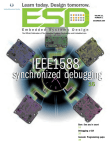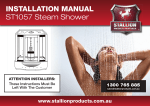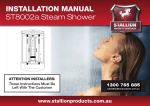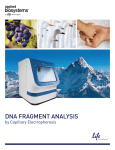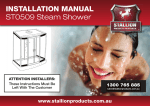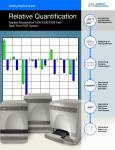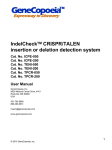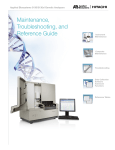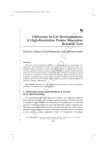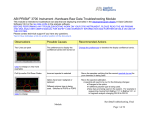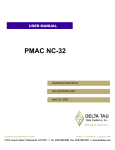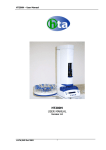Download ABI PRISM SNaPshot™ Multiplex Kit
Transcript
ABI PRISM SNaPshot Multiplex Kit ® ™ Protocol For Research Use Only. Not for use in diagnostic procedures. © Copyright 2000, Applied Biosystems For Research Use Only. Not for use in diagnostic procedures. PE Corporation is committed to providing the world’s leading technology and information for life scientists. PE Corporation consists of the Applied Biosystems and Celera Genomics businesses. These products may be covered under U.S. Patents 5,366,860; 5,188,934; 5,654,442; 5,840,000; 5,885,778; 5,936,087; 6,008,379; 6,020,481; 6,051,719; their foreign counterparts, other patents, and patents pending. Notice to Purchaser: Limited License The purchase of this product includes a limited, nontransferable license under U.S. Patent 5,075,216 or its foreign counterparts, owned by Roche Molecular Systems, Inc. and F. Hoffmann-La Roche Ltd. (“Roche”) to use only this amount of the product for DNA sequencing and related processes described in said patent solely for the research and development activities of the purchaser. No license under these patents to use the PCR process is conveyed expressly or by implication to the purchaser by the purchase of this product. A license to use the PCR process for certain research and development activities accompanies the purchase of certain reagents from licensed suppliers such as PE when used in conjunction with an Authorized Thermal Cycler, or is available from Applied Biosystems, 850 Lincoln Centre Drive, Foster City, California 94404, or at Roche Molecular Systems Inc. 1145 Atlantic Avenue, Alameda, California 94501. Notice to Purchaser: Limited License This kit (reagent) is sold pursuant to a limited sublicense from Amersham International plc under one or more U.S. Patent Nos. 5,498,523, 4,994,372, U.S. Patent Application Serial Nos. 08/324437, 08/337615, and corresponding foreign patents and patent applications. The purchase of this kit (reagent) includes a limited nonexclusive sublicense (without the right to resell, repackage, or further sublicense) under such patent rights to use this reagent for DNA sequencing or fragment length analysis solely with an Applied Biosystems commercial automated sequencing machine or other authorized DNA sequencing machines that have been authorized for such use by Applied Biosystems, or for manual sequencing. No license is hereby granted for the use of this kit or the reagents therein, in any other automated sequencing machine. Such sublicense is granted solely for research and other uses that are not unlawful. No other license is granted expressly, implied, or by estoppel. For information concerning the availability of additional license to practice the patented methodologies, contact: Amersham Life Science, Inc., Vice President, Regulatory Affairs, P.O. Box 22440, Cleveland, Ohio 44122. Patents are pending in countries outside the United States. Notice to Purchaser: End User License The purchase price of this product includes a limited, non-transferable license under U.S. Patent Nos. 5,888,819, 6,004,744 and their foreign counterparts owned by Orchid BioSciences, Inc. of Princeton, New Jersey, to perform 1000, 10,000, or 50,000 Genotypes (For purposes of this End User License, Genotype means the detection or quantification of an individual SNP within a single sample.) solely for the detection and analysis of SNPs in samples for research purposes only and only on automated electrophoresis nucleotide sequencers. This license specifically excludes performing services for a third party and any and all medical diagnostic or therapeutic uses. Information about purchasing licenses to practice primer extension technology covered by Orchid BioSciences, Inc. patents for any other use may be obtained by contacting the Senior Director for Business Development at Orchid BioSciences, Inc. Princeton, New Jersey, U.S.A., at (650) 750-2200. ABI PRISM and its design, Applied Biosystems, GeneScan, Genotyper, MicroAmp, BioLIMS, and BioMerge are registered trademarks and AB(Design), ABI, LIZ, POP-4, POP-5, POP-6, ROX, TAMRA and SNaPshot are trademarks of PE Corporation or its subsidiaries in the U.S. and certain other countries. AmpliTaq, GeneAmp, and TaqMan are registered trademarks of Roche Molecular Systems, Inc. GBA is a registered trademark of Molecular Tools Inc. All other trademarks are the sole property of their respective owners. Contents Product and Protocol Overview . . . . . . . . . . . . . . . . . . . . . . . . . . . . . . . . . . . . .1 About the Kit. . . . . . . . . . . . . . . . . . . . . . . . . . . . . . . . . . . . . . . . . . . . . .1 Product Overview . . . . . . . . . . . . . . . . . . . . . . . . . . . . . . . . . . . . . . . . . .1 Kit Chemistry Based on Single Base Extension . . . . . . . . . . . . . . . . . . .1 Dye Assignments . . . . . . . . . . . . . . . . . . . . . . . . . . . . . . . . . . . . . . . . . .2 Platforms and Software. . . . . . . . . . . . . . . . . . . . . . . . . . . . . . . . . . . . . .2 About This Protocol . . . . . . . . . . . . . . . . . . . . . . . . . . . . . . . . . . . . . . . .2 Kit Contents and Storage . . . . . . . . . . . . . . . . . . . . . . . . . . . . . . . . . . . . . . . . . .3 SNaPshot Multiplex Kit . . . . . . . . . . . . . . . . . . . . . . . . . . . . . . . . . . . . .3 One Kit Available in Three Formats . . . . . . . . . . . . . . . . . . . . . . . . . . . .3 Storing the Reagents . . . . . . . . . . . . . . . . . . . . . . . . . . . . . . . . . . . . . . . .3 Required Software and Materials . . . . . . . . . . . . . . . . . . . . . . . . . . . . . . . . . . .4 Overview. . . . . . . . . . . . . . . . . . . . . . . . . . . . . . . . . . . . . . . . . . . . . . . . .4 GeneScan-120 LIZ Size Standard Recommended . . . . . . . . . . . . . . . . .4 Data Collection Software and/or GeneScan Run Module Required. . . .4 Materials Required but Not Included . . . . . . . . . . . . . . . . . . . . . . . . . . .5 Safety . . . . . . . . . . . . . . . . . . . . . . . . . . . . . . . . . . . . . . . . . . . . . . . . . . . . . . . . .6 Documentation User Attention Words . . . . . . . . . . . . . . . . . . . . . . . . . .6 Chemical Hazard Warning . . . . . . . . . . . . . . . . . . . . . . . . . . . . . . . . . . .6 Site Preparation and Safety Guide . . . . . . . . . . . . . . . . . . . . . . . . . . . . .7 Ordering MSDSs. . . . . . . . . . . . . . . . . . . . . . . . . . . . . . . . . . . . . . . . . . .8 Overview of the Procedure . . . . . . . . . . . . . . . . . . . . . . . . . . . . . . . . . . . . . . . .9 Preparing Your PCR Template for Primer Extension . . . . . . . . . . . . . . . . . . .10 Purpose . . . . . . . . . . . . . . . . . . . . . . . . . . . . . . . . . . . . . . . . . . . . . . . . .10 About the Templates . . . . . . . . . . . . . . . . . . . . . . . . . . . . . . . . . . . . . . .10 Methods for Preparing PCR Templates . . . . . . . . . . . . . . . . . . . . . . . .10 i PCR Purification Kits. . . . . . . . . . . . . . . . . . . . . . . . . . . . . . . . . . . . . . 10 SAP and Exo I Treatment. . . . . . . . . . . . . . . . . . . . . . . . . . . . . . . . . . . 11 Preparing the Control Reactions . . . . . . . . . . . . . . . . . . . . . . . . . . . . . . . . . . . 12 About the Control Reactions . . . . . . . . . . . . . . . . . . . . . . . . . . . . . . . . 12 Negative Control Reaction . . . . . . . . . . . . . . . . . . . . . . . . . . . . . . . . . . 12 Preparing the Control Reactions . . . . . . . . . . . . . . . . . . . . . . . . . . . . . 13 Preparing Your Sample Reactions. . . . . . . . . . . . . . . . . . . . . . . . . . . . . . . . . . 14 Overview . . . . . . . . . . . . . . . . . . . . . . . . . . . . . . . . . . . . . . . . . . . . . . . 14 SNaPshot Primer Design . . . . . . . . . . . . . . . . . . . . . . . . . . . . . . . . . . . 14 Pooling PCR Amplified SNaPshot Templates . . . . . . . . . . . . . . . . . . . 14 Pooling SNaPshot Primers . . . . . . . . . . . . . . . . . . . . . . . . . . . . . . . . . . 14 Setting Up Your Sample Reaction . . . . . . . . . . . . . . . . . . . . . . . . . . . . 15 Thermal Cycling and Post-Extension Treatment . . . . . . . . . . . . . . . . . . . . . . 16 Overview . . . . . . . . . . . . . . . . . . . . . . . . . . . . . . . . . . . . . . . . . . . . . . . 16 Thermal Cycling . . . . . . . . . . . . . . . . . . . . . . . . . . . . . . . . . . . . . . . . . 16 Post-Extension Treatment . . . . . . . . . . . . . . . . . . . . . . . . . . . . . . . . . . 16 Electrophoresis on the ABI PRISM 310 Genetic Analyzer . . . . . . . . . . . . . . . 18 Overview . . . . . . . . . . . . . . . . . . . . . . . . . . . . . . . . . . . . . . . . . . . . . . . 18 The Polymer . . . . . . . . . . . . . . . . . . . . . . . . . . . . . . . . . . . . . . . . . . . . . 18 GeneScan E5 Run Module Parameters . . . . . . . . . . . . . . . . . . . . . . . . 18 Adjusting the Run Time . . . . . . . . . . . . . . . . . . . . . . . . . . . . . . 18 Adjusting the Injection Time for Signal Variability . . . . . . . . . 18 Running Matrix Standards . . . . . . . . . . . . . . . . . . . . . . . . . . . . . . . . . . 19 Preparing Samples . . . . . . . . . . . . . . . . . . . . . . . . . . . . . . . . . . . . . . . . 20 Electrophoresis on the ABI PRISM 3100 Genetic Analyzer . . . . . . . . . . . . . . 22 Setting Up the Analyzer . . . . . . . . . . . . . . . . . . . . . . . . . . . . . . . . . . . . 22 Running Matrix Standards . . . . . . . . . . . . . . . . . . . . . . . . . . . . . . . . . . 22 Preparing the Samples . . . . . . . . . . . . . . . . . . . . . . . . . . . . . . . . . . . . . 22 GeneScan Run Parameters . . . . . . . . . . . . . . . . . . . . . . . . . . . . . . . . . . 23 Electrophoresis on the ABI PRISM 3700 DNA Analyzer . . . . . . . . . . . . . . . . 24 Setting Up the Analyzer . . . . . . . . . . . . . . . . . . . . . . . . . . . . . . . . . . . . 24 Running Matrix Standards . . . . . . . . . . . . . . . . . . . . . . . . . . . . . . . . . . 24 Preparing the Samples . . . . . . . . . . . . . . . . . . . . . . . . . . . . . . . . . . . . . 24 ii Setting Up GeneScan Parameters . . . . . . . . . . . . . . . . . . . . . . . . . . . . .25 Data Analysis . . . . . . . . . . . . . . . . . . . . . . . . . . . . . . . . . . . . . . . . . . . . . . . . . .27 Overview. . . . . . . . . . . . . . . . . . . . . . . . . . . . . . . . . . . . . . . . . . . . . . . .27 Analyzing Sample Files on the 310 Instrument . . . . . . . . . . . . . . . . . .27 Analyzing Sample Files on the 3100 and 3700 Instruments. . . . . . . . .27 Example of Control Reaction . . . . . . . . . . . . . . . . . . . . . . . . . . . . . . . .28 Allele Calling . . . . . . . . . . . . . . . . . . . . . . . . . . . . . . . . . . . . . . . . . . . .28 Appendix A. SNaPshot Primer Design and Evaluation Recommendations .29 Appendix B. Converting Nanograms to Picomoles . . . . . . . . . . . . . . . . . . . .31 Procedure . . . . . . . . . . . . . . . . . . . . . . . . . . . . . . . . . . . . . . . . . . . . . . .31 Appendix C. Troubleshooting . . . . . . . . . . . . . . . . . . . . . . . . . . . . . . . . . . . .32 Troubleshooting Low Signal. . . . . . . . . . . . . . . . . . . . . . . . . . . . . . . . .32 Troubleshooting Extraneous Peaks. . . . . . . . . . . . . . . . . . . . . . . . . . . .33 Troubleshooting Sizing Problems. . . . . . . . . . . . . . . . . . . . . . . . . . . . .36 Appendix D. Technical Support . . . . . . . . . . . . . . . . . . . . . . . . . . . . . . . . . .37 Contacting Technical Support. . . . . . . . . . . . . . . . . . . . . . . . . . . . . . . .37 To Contact Technical Support by E-Mail . . . . . . . . . . . . . . . . . . . . . . .37 Hours for Telephone Technical Support . . . . . . . . . . . . . . . . . . . . . . . .37 To Contact Technical Support by Telephone or Fax . . . . . . . . . . . . . . .38 In North America . . . . . . . . . . . . . . . . . . . . . . . . . . . . . . . . . . . .38 To Reach Technical Support Through the Internet . . . . . . . . . . . . . . . .41 To Obtain Documents on Demand . . . . . . . . . . . . . . . . . . . . . . . . . . . .42 iii Product and Protocol Overview About the Kit The ABI PRISM® SNaPshot™ Multiplex Kit is designed to interrogate up to ten single nucleotide polymorphisms (SNPs) at known locations on one to ten DNA templates in a single tube. Control Template DNA and Primer Mix included in the SNaPshot Multiplex Kit provides reagents for control reactions. Product Overview Single nucleotide polymorphisms detection using the ABI PRISM SNaPshot Multiplex Kit requires the following components: ♦ SNaPshot Multiplex Ready Reaction Mix ♦ Your template and primers The ABI PRISM SNaPshot Multiplex Control Template DNA and Primer Mix provides Control Primers and Control Template to perform control reactions only. Kit Chemistry The chemistry is based on the dideoxy single-base extension of an Based on Single unlabeled oligonucleotide primer (or primers). Base Extension ♦ Each primer binds to a complementary template in the presence of fluorescently labeled ddNTPs and AmpliTaq® DNA Polymerase, FS. ♦ The polymerase extends the primer by one nucleotide, adding a single ddNTP to its 3´ end. 1 Dye Assignments The fluorescent dyes are assigned to the individual ddNTPs as follows: ddNTP Dye Label Color of Analyzed Data A dR6G Green C dTAMRA™ Black G dR110 Blue dROX™ Red T (U) Platforms and Products generated using the ABI PRISM SNaPshot Multiplex Kit can be Software analyzed with GeneScan ® Analysis Software version 3.1 or higher. The kits can be run on the following platforms: ♦ ABI PRISM® 310 Genetic Analyzer ♦ ABI PRISM® 3100 Genetic Analyzer ♦ ABI PRISM® 3700 DNA Analyzer About This This protocol describes how to: Protocol ♦ Prepare sample reactions using your own template(s) and primer(s) or the control template and control primers. ♦ Perform SNaPshot reactions by thermal cycling and conduct post-extension treatment of the products. ♦ Electrophorese the samples and analyze the data. To view a flowchart of the procedure refer to “Overview of the Procedure” on page 9. 2 Kit Contents and Storage SNaPshot The ABI PRISM SNaPshot Multiplex Kit is available in three reaction Multiplex Kit sizes. Using this kit, you can perform your own reactions and also perform 30 control reactions with the control template and primers provided. One Kit Available in Three Formats Kit ABI PRISM SNaPshot™ Multiplex Kit Number of Reactionsa 100 Part Number 4323151 1000 4323154 5000 4323155 a. Each kit contains Multiplex Control Template and Multiplex Control Primers for 30 control reactions The kit contains the following items: Kit Components Contents SNaPshot Multiplex Ready Reaction Mix AmpliTaq® DNA Polymerase, FS Fluorescently labeled ddNTPs Reaction buffer SNaPshot Multiplex Control Primer Mix (30 µL total) 20A primer (0.05 pmol/µL) 28G/A primer (0.10 pmol/µL) 36G primer (0.05 pmol/µL) 44T primer (0.30 pmol/µL) 52C/T primer (0.30 pmol/µL) 60C primer (0.30 pmol/µL) SNaPshot Multiplex Control Template (60 µL total) Amplicon from CEPH DNA Protocol P/N 4323357 Quick Reference Card P/N 4323975 Storing the Upon receipt, store the ABI PRISM SNaPshot Multiplex Kit at –15 to Reagents –25 °C in a constant-temperature freezer. 3 Required Software and Materials Overview This section describes the software and materials necessary for using the ABI PRISM SNaPshot Multiplex Kit. GeneScan-120 LIZ Primers used in a single reaction for multiloci interrogation need to differ Size Standard significantly in length to avoid overlap between the final SNaPshot Recommended products. To analyze the final products successfully and robustly, a 5th dye-labeled internal size standard specifically designed for small fragments should be used. The GeneScan™-120 LIZ™ size standard has been designed specifically for use with the SNaPshot Muiltiplex Kit. Data Collection One of the following Data Collection Software and/or GeneScan Run Software and/or Modules is required: GeneScan Run 310 Genetic Analyzer: Module Required ♦ 310 Data Collection version 2.1 ♦ GS STR POP4 (1 mL) E5 3100 Genetic Analyzer: ♦ 3100 Data Collection version 1.0 ♦ SNP36_POP4 default module 3700 DNA Analyzer: 4 ♦ 3700 Data Collection version 1.1 (enabled with 3700 Data Collection 5-Dye Update File P/N 4324208) ♦ SNP1_1POP5 Materials The following materials are required but not included: Required but Not Source Included Item One of the following instruments with 5-dye capability: Applied Biosystems ♦ ABI PRISM 310 Genetic Analyzer ♦ ABI PRISM 3100 Genetic Analyzer with POP-4 polymer and 36-cm array ♦ ABI PRISM 3700 DNA Analyzers with POP-5 polymer and 50-cm array. GeneAmp® PCR System 9600 thermal cycler with appropriate tubes or plate, and caps GeneScan® software v. 3.1 or higher Matrix Standard Set DS-02 [dR110, dRGG, dTAMRA™, dROX™, LIZ™] Applied Biosystems 310 4323050 3100 4323014 3700 4323785 GeneScan™-120 LIZ™ size standard 4324211 Hi-Di™ formamide, 25-mL bottle Applied Biosystems (P/N 4311320) 1X TE, pH 7.0 Major laboratory supplier (MLS) Centrifuge with 96-well plate adapter MLS Deionized water MLS Disposable gloves MLS Pipette tips, aerosol resistant MLS Shrimp Alkaline Phosphatase (SAP) USB Corporation (P/N 70092X, 5000 Units) (P/N 70092Z, 1000 Units) or Calf Intestinal Phosphatase (CIP) (P/N 70092Y, 500 Units) New England BioLabs (P/N 290L, 5000 Units) (P/N 290S, 1000 Units) 5 The following materials are required but not included: Item Source Exo I USB Corporation (continued) (Exonuclease I, P/N 70073Z) or PCR Clean Up Kit or High Pure™ PCR Product Purification Kit Roche Molecular Biochemicals (P/N 1696513, 100 reactions) Roche Molecular Biochemicals (P/N 1732668, 50 reactions) (P/N 1732676, 250 reactions) Safety Documentation Five user attention words appear in the text of all Applied Biosystems User Attention user documentation. Each word implies a particular level of observation Words or action as described below. Note Calls attention to useful information. IMPORTANT Indicates information that is necessary for proper instrument operation. ! CAUTION Indicates a potentially hazardous situation which, if not avoided, may result in minor or moderate injury. It may also be used to alert against unsafe practices. ! WARNING Indicates a potentially hazardous situation which, if not avoided, could result in death or serious injury. ! DANGER Indicates an imminently hazardous situation which, if not avoided, will result in death or serious injury. This signal word is to be limited to the most extreme situations. Chemical Hazard ! WARNING CHEMICAL HAZARD. Some of the chemicals used with Warning Applied Biosystems instruments and protocols are potentially hazardous and can cause injury, illness, or death. 6 ♦ Read and understand the material safety data sheets (MSDSs) provided by the chemical manufacturer before you store, handle, or work with any chemicals or hazardous materials. ♦ Minimize contact with and inhalation of chemicals. Wear appropriate personal protective equipment when handling chemicals (e.g., safety glasses, gloves, or protective clothing). For additional safety guidelines, consult the MSDS. ♦ Do not leave chemical containers open. Use only with adequate ventilation. ♦ Check regularly for chemical leaks or spills. If a leak or spill occurs, follow the manufacturer’s cleanup procedures as recommended on the MSDS. ♦ Comply with all local, state/provincial, or national laws and regulations related to chemical storage, handling, and disposal. Site Preparation A site preparation and safety guide is a separate document sent to all and Safety Guide customers who have purchased an Applied Biosystems instrument. Refer to the guide written for your instrument for information on site preparation, instrument safety, chemical safety, and waste profiles. 7 Ordering MSDSs You can order free additional copies of MSDSs for chemicals manufactured or distributed by Applied Biosystems using the contact information below. To order MSDSs... Then... Over the Internet a. Go to our Web site at www.appliedbiosystems.com/techsupp. b. Click MSDSs. If you have... Then... The MSDS document number or the Document on Demand index number Enter one of these numbers in the appropriate field on this page The product part number Select Click Here, then enter the part number or keyword(s) in the field on this page. Keyword(s) c. You can open and download a PDF (using Adobe® Acrobat Reader) of the document by selecting it, or you can choose to have the document sent to you by fax or email. By automated telephone service Use “Documents on Demand” under “Technical Support.” By telephone in the United States Dial 1-800-327-3002, then press 1. By telephone from Canada By telephone from any other country 8 To order in... Dial 1-800-668-6913 and... English Press 1, then 2, then 1 again French Press 2, then 2, then 1 See “Regional Offices Sales and Service” under “Technical Support.” Overview of the Procedure PCR Purification Kit TM Exo Multiplex Genotyping PCR System B-D 5 4 3 2 1 Electrophorese samples on 310, 3100, or 3700 instrument 9600 ABI PRISM 9 Preparing Your PCR Template for Primer Extension Purpose This section describes how to prepare your PCR product template before primer extension. About the There are two kinds of templates that you can use in primer extension Templates reactions: ♦ Plasmid templates ♦ PCR products While plasmid templates do not require cleanup before primer extension, PCR product templates must be purified. Depending on the specific template, 0.01 to 0.40 pmol of the template should be used in the SNaPshot reactions. Methods for After PCR amplification, the resulting template is in solution, along with Preparing PCR primers, dNTPs, and enzyme and buffer components. To avoid Templates participation in the subsequent primer-extension reaction, primers and unincorporated dNTPs must be removed. We recommend the following methods for purifying PCR products: Topic See Page PCR Purification Kits 10 SAP and Exo I Treatment 11 PCR Purification High Pure™ PCR Product Purification (P/N 1732668, 50 reactions, Kits 1732676, 250 reactions) or PCR Clean Up Kits (P/N 1696513, 100 reactions) can be purchased from Roche Molecular Biochemicals. Refer to the manufacturer’s instructions for the procedure. 10 SAP and Exo I To treat PCR products using SAP and Exo I: Treatment Step 1 Action Add the following to 15 µL of PCR product: ♦ 5 units of SAP ♦ 2 unit of Exo I Use the following guidelines for enzyme treatment: ♦ Reaction volume can be adjusted up or down. PCR products can be from a single PCR reaction or multiple PCR reactions. We recommend that you purify individual PCR products and combine the purified products in the next step. ♦ To ensure a low background, we strongly recommend that the relative ratio of PCR product, SAP, and Exo I be kept constant, i.e., 5 units of SAP and 2 units of Exo I for every 15 µL of PCR product. ♦ Because of the high glycerol concentration in undiluted SAP and Exo I, add each enzyme into the PCR mixture one at a time. ♦ Exo I can be freshly diluted in a buffer containing 80 mM Tris-HCl (pH = 9.05) and 2 mM MgCl2. Do not store diluted Exo I. 2 Mix thoroughly and incubate at 37 °C for 1 hour. Note Because of the high glycerol concentration in undiluted SAP and Exo I, vortex briefly to mix. 3 Incubate at 75 °C for 15 minutes to inactivate the enzymes. 4 Keep on ice or at 4 °C. For longer storage, store at –20 °C. 11 Preparing the Control Reactions About the Control Included in each kit are a Multiplex Control Primer Mix tube containing Reactions six distinct primers and a Multiplex Control Template tube containing an amplicon from CEPH DNA. The control primers are listed in the table below. Multiplex Control Primer Mix Length of Final Products (nt) Signal Color Heterozygosity 20A primer 21 Green Homozygote 28G/A primer 29 Blue/green Heterozygote 36G primer 37 Blue Homozygote 44T primer 45 Red Homozygote 52C/T primer 53 Black/red Heterozygote 60C primer 61 Black Homozygote Note Due to the influence of the dye on the mobility shift of the DNA fragments, the reported sizes will differ by a few bases from the actual sizes. This is particularly true with the shorter fragments as the relative contribution of the dye is greater. Negative Control Run one negative control reaction without control template DNA. Reaction 12 Preparing the To prepare the control reactions: Control Reactions Step Action 1 Label two 0.2-mL MicroAmp ® tubes, one for the positive control reaction and one for the negative control reaction. 2 Thaw the SNaPshot Multiplex Ready Reaction Mix, Control Template, and Control Reaction Primer Mix on ice. Prepare the following reaction mix on ice: Positive Control (µL) Negative Control (µL) SNaPshot Multiplex Ready Reaction Mix 5 5 SNaPshot Multiplex Control Template 2 0 SNaPshot Multiplex Control Primer Mix 1 1 Item 3 Deionized water 2 4 Total 10 10 Mix and spin briefly. Note Keep the SNaPshot mixture on ice before putting it into the thermal cycler. Leaving the mixture at ambient temperature for 20 minutes or longer may result in a higher background. 4 Proceed to “Thermal Cycling and Post-Extension Treatment” on page 16. 13 Preparing Your Sample Reactions Overview This section describes how you set up multiplex SNaPshot reactions using your templates and primers. SNaPshot Primer See “SNaPshot Primer Design and Evaluation Recommendations” on Design page 29 for recommendations on designing and evaluating primers. Pooling PCR Amplified SNaPshot Templates If you have multiple purified PCR amplified samples to run in a single SNaPshot reaction, mix equal volumes (e.g., 2 µL each) of these products in a tube and place the tube on ice. Note SNaPshot Multiplex Ready Mix gives satisfactory results over a range of 0.01 to 0.40 pmol of PCR products (depending on template) in a 10-µL reaction. Note For a description of how to convert nanograms per microliter to picomoles per microliter, refer to Appendix B on page 31. Pooling SNaPshot All the primers to be used in a single SNaPshot reaction should be Primers premixed to give a final concentration of 0.2 µM for each primer. Place the primer mixture on ice. Note SNaPshot Multiplex Ready Mix has been designed to exhaust all primers in the reaction. The recommended starting concentration for each primer is 0.2 µM. If a particular primer has a consistently low or high signal, increase or decrease the concentration of that primer. Successful results have been obtained using primers with concentrations that range between 0.05 µM and 1 µM in a six-primer mixture. Adjusting the template concentration is usually not required. 14 Setting Up Your To set up your sample reaction: Sample Reaction Step 1 Action Thaw the SNaPshot Multiplex Ready Reaction Mix on ice. Note Adjust the volume of deionized water to accommodate any changes in primer or template volumes. Note Make a master mix if you are running several samples containing common components. Combine the following: Item 2 Volume (µL/ Sample) SNaPshot Multiplex Ready Reaction Mix 5 Pooled PCR products 3 Pooled SNaPshot primers 1 Deionized water 1 Total 10 Mix thoroughly and spin briefly. Aliquot 10 µL into each MicroAmp tube/well. Note It is important to keep the reaction mixture on ice before putting it into the thermal cycler. Leaving the mixture at ambient temperature for 20 minutes or longer may lead to higher background. 3 Proceed to “Thermal Cycling and Post-Extension Treatment” on page 16. 15 Thermal Cycling and Post-Extension Treatment Overview This section describes how to conduct thermal cycling and how to remove unincorporated ddNTPs after thermal cycling. Thermal Cycling To conduct thermal cycling: Step Action 1 Place the tubes in a GeneAmp 9600 thermal cycler, and set the volume to 10 µL. 2 Repeat the following for 25 cycles: ♦ Rapid thermal ramp to 96 °C ♦ 96 °C for 10 seconds ♦ Rapid thermal ramp to 50 °C ♦ 50 °C for 5 seconds ♦ Rapid thermal ramp to 60 °C ♦ 60 °C for 30 seconds Note Thermal cycling takes approximately 1 hour and 10 minutes to complete. 3 Rapid thermal ramp to 4 °C, and hold until ready for post-extension treatment. Post-Extension IMPORTANT Left untreated, the unincorporated [F]ddNTPs will co-migrate Treatment with the fragment(s) of interest. Removal of the 5´ phosphoryl groups by phosphatase treatment alters the migration of the unincorporated [F]ddNTPs and thus prohibits interference. To conduct post-extension treatment: Step 1 Action Add one of the following to the reaction mixture, mix thoroughly, and incubate at 37 °C for 1 hour. Note Because of the high glycerol concentration in the undiluted SAP, vortex briefly to mix. ♦ 1.0 Unit of Shrimp Alkaline Phosphatase (SAP) or ♦ 1.0 Unit of Calf Intestinal Phosphatase (CIP) 16 To conduct post-extension treatment: Step (continued) Action 2 Deactivate the enzyme by incubating at 75 °C for 15 minutes. 3 Samples may be placed at 4 °C for up to 24 hours prior to electrophoresis on the 310/3100/3700 systems. For storage longer than 24 hours, store the samples at –20 °C. 4 If you are running an... Then proceed to... ABI PRISM 310 Genetic Analyzer “Electrophoresis on the ABI PRISM 310 Genetic Analyzer” on page 18. ABI PRISM 3100 Genetic Analyzer “Electrophoresis on the ABI PRISM 3100 Genetic Analyzer” on page 22. ABI PRISM 3700 DNA Analyzer “Electrophoresis on the ABI PRISM 3700 DNA Analyzer” on page 24. 17 Electrophoresis on the ABI PRISM 310 Genetic Analyzer Overview This section describes electrophoresis of SNaPshot products on the ABI PRISM 310 Genetic Analyzer using the 310 Data Collection version 2.1. Note For more information about using the ABI PRISM 310 Genetic Analyzer, refer to the ABI PRISM 310 Genetic Analyzer User’s Manual (P/N 903565). The Polymer The SNaPshot kits may be used with: ♦ POP-4™ polymer, in conjunction with GS POP-4 (1mL) E5 module ! CAUTION CHEMICAL HAZARD. POP-4 polymer may cause eye, skin, and respiratory tract irritation. Please read the MSDS, and follow the handling instructions. Wear appropriate protective eyewear, clothing, and gloves. Use for research and development purposes only. GeneScan E5 Run The GeneScan E5 Run Module encodes the following parameters on Module the 310 instrument: Parameters Parameter Control Module GS POP-4 (1mL) E5 Injection time 5 seconds Electrophoresis voltage 15 kV Collection time 24 minutes EP voltage 15 kV Heat plate temperature 60 °C Syringe pump time 150 seconds Preinjection EP 120 seconds Adjusting the Run Time Depending upon primer length, the peaks of interest may appear well before the run ends. For this reason, you may want to shorten the collection time. Adjusting the Injection Time for Signal Variability If increased or decreased signal is routinely observed, you may want to decrease or increase injection times, respectively. For a description of 18 how to adjust the injection time on the 310 Genetic Analyzer, refer to the ABI PRISM 310 Genetic Analyzer User’s Manual (P/N 903565). Running Matrix If you are running the ABI PRISM SNaPshot Multiplex Kit reactions for Standards the first time, you will need a Matrix Standard Set DS-02 [dR110, dRGG, dTAMRA, dROX, LIZ] for the 310 Genetic Analyzer system. Run the ABI PRISM DS-02 Matrix Standards Kit (P/N 4323050), along with the other control and sample reactions. Refer to the DS-02 Matrix Standards Kit product insert for directions on how to prepare the DS-02 matrix standards. 19 Preparing Samples Follow the instructions below if you are using an ABI PRISM 310 Genetic Analyzer to run your samples. To prepare samples for the 310 Genetic Analyzer: Step 1 Action Thaw Hi-Di formamide, SNaPshot products, and the GeneScan-120 LIZ size standard. Vortex to mix and spin briefly. ! WARNING CHEMICAL HAZARD. Formamide is harmful if absorbed through the skin and may cause irritation to the eyes, skin, and respiratory tract. It may cause damage to the central nervous system and the male and female reproductive systems, and is a possible birth defect hazard. Please read the MSDS, and follow the handling instructions. Wear appropriate protective eyewear, clothing, and gloves. 2 Add 9 µL of Hi-Di formamide into each tube. 3 Add 0.5 µL of the SNaPshot product and 0.5 µL GeneScan-120 LIZ size standard into each tube. Note Total volume for injection is 10 µL Note Dilute the control reaction 1:2. Mix 0.5 µL of the diluted products with 0.5 µL of GeneScan-120 LIZ size standard. Note If you want to use volumes greater than 0.5 µL, the following mixing steps are suggested: a. Dilute 2 µL of SNaPshot product in 6 µL of Hi-Di formamide b. Dilute 2 µL of GeneScan-120 LIZ in 6 µL of Hi-Di formamide (enough for 4 samples) c. Mix: – 2 µL of diluted SNaPshot product – 2 µL of diluted GeneScan-120 LIZ size standard – 6 µL of Hi-Di formamide 20 4 Vortex briefly and quick spin. 5 Denature the samples by placing them at 95 °C for 5 minutes. 6 Place the samples on ice or at 4 °C until you are ready to load them on the 310 Genetic Analyzer. 7 Quick spin or tap the tubes or plates to bring liquid to the bottom of the tubes. To prepare samples for the 310 Genetic Analyzer: Step 8 (continued) Action Refer to the ABI PRISM 310 User’s Manual for specific directions on the following: a. Verify that you have chosen GeneScan Run Module E5. b. Confirm the injection time. c. Verify that you have selected the DS-02 GeneScan Matrix Set for the 310 Genetic Analyzer system. d. Verify that you have selected the GeneScan-120 LIZ size standard analysis parameter for automatic data analysis. Note To set up the GeneScan-120 LIZ size standard automatic analysis, refer to the instructions in the GeneScan-120 LIZ size standard product insert. 21 Electrophoresis on the ABI PRISM 3100 Genetic Analyzer Setting Up the Before any run, make sure that the 3100 Genetic Analyzer is set up with Analyzer a 36-cm capillary array and POP-4 polymer. Running Matrix If you are running the ABI PRISM SNaPshot Multiplex Kit reactions for Standards the first time, you will need a Matrix Standard Set DS-02 [dR110. dRGG, dTAMRA, dROX, LIZ] for the 3100 Genetic Analyzer (P/N 4323014). Refer to the DS-02 Matrix Standards Kit product insert for directions on how to prepare the DS-02 matrix standards. Preparing the To prepare samples for the 3100 Genetic Analyzer: Samples Step 1 Action Thaw Hi-Di formamide, SNaPshot products, and the GeneScan-120 LIZ size standard. Vortex to mix and spin briefly. ! WARNING CHEMICAL HAZARD. Formamide is harmful if absorbed through the skin and may cause irritation to the eyes, skin, and respiratory tract. It may cause damage to the central nervous system and the male and female reproductive systems, and is a possible birth defect hazard. Please read the MSDS, and follow the handling instructions. Wear appropriate protective eyewear, clothing, and gloves. 2 Add 9 µL of Hi-Di formamide to each well. 3 Add 0.5 µL of the SNaPshot products and 0.5 µL of GeneScan-120 LIZ size standard into each well and seal the plates. Note Total volume for injection is 10 µL. Note If you want to use volumes greater than 0.5 µL, the following mixing steps are suggested: a. Dilute 2 µL of SNaPshot product in 6 µL of Hi-Di formamide. b. Dilute 2 µL of GS120 in 6 µL of Hi-Di formamide (enough for four samples). c. Mix: – 2 µL of diluted SNaPshot product – 2 µL of diluted GeneScan-120 LIZ size standard – 6 µL of Hi-Di formamide 22 To prepare samples for the 3100 Genetic Analyzer: Step (continued) Action 4 Vortex briefly and spin briefly. 5 Denature the samples by placing them at 95 °C for 5 minutes. 6 Place the samples on ice or at 4 °C until you are ready to load the analyzer. GeneScan Run To start the run: Parameters Step Action 1 In the New Plate setup, select Dye Set E5 and SNP36_POP4 default module. 2 Start the run. Note To set up the GeneScan-120 LIZ size standard automatic analysis, refer to the instructions in the GeneScan-120 LIZ size standard product insert. 23 Electrophoresis on the ABI PRISM 3700 DNA Analyzer Setting Up the Before any run, make sure that the 3700 DNA Analyzer is set up with a Analyzer 50-cm capillary array and POP-5 polymer. Running Matrix If you are running the ABI PRISM SNaPshot Multiplex Kit reactions for Standards the first time, you will need a Matrix Standard Set DS-02 for the 3700 DNA Analyzer (P/N 4323785). Refer to the DS-02 Matrix Standards Kit product insert for directions on how to prepare the DS-02 matrix standards. Preparing the To prepare samples for the 3700 DNA Analyzer: Samples Step 1 Action Thaw Hi-Di formamide, SNaPshot products, and the GeneScan-120 LIZ size standard. Vortex to mix and spin briefly. ! WARNING CHEMICAL HAZARD. Formamide is harmful if absorbed through the skin and may cause irritation to the eyes, skin, and respiratory tract. It may cause damage to the central nervous system and the male and female reproductive systems, and is a possible birth defect hazard. Please read the MSDS, and follow the handling instructions. Wear appropriate protective eyewear, clothing, and gloves. 2 Add 9 µL of Hi-Di formamide to each well. 3 Add 0.5 µL of SNaPshot products and 0.5 µL of GeneScan-120 LIZ size standard to each well, and seal the plates. Note Total volume for injection is 10 µL. Note If you want to use volumes greater than 0.5 µL, the following mixing steps are suggested: a. Dilute 2 µL of SNaPshot product in 6 µL of Hi-Di formamide. b. Dilute 2 µL of GeneScan-120 LIZ in 6 µL of Hi-Di formamide (enough for four samples). c. Mix: – 2 µL of diluted SNaPshot product – 2 µL of diluted GeneScan-120 LIZ size standard – 6 µL of Hi-Di formamide 4 24 Vortex briefly and spin briefly. To prepare samples for the 3700 DNA Analyzer: Step 5 (continued) Action Denature the samples by placing them at 95 °C for 5 minutes. Place the samples on ice or at 4 °C until you are ready to load the analyzer. Setting Up Setting up the GeneScan application: GeneScan Step Action Parameters 1 In the New Plate setup, select Dye Set E5 and SNP1_1POP5 module. Note Data collection time in the default SNP1_1POP5 module is 900 seconds. To ensure that all 9 peaks in GeneScan-120 LIZ size standard are collected, extend the data collection time to 1100 seconds. Note If the signal variation from the left to the right side of the array becomes a concern, try lowering the running voltage to 6 KV. You will also need to extend the data delay time from 900 seconds to 1200 seconds and the data collection time from 900 seconds to 1800 seconds (refer to step 3 for information on modifying the module). Note To set up the GeneScan-120 LIZ size standard automatic analysis, refer to the instructions in the GeneScan-120 LIZ size standard product insert. 2 Start the run. 25 Setting up the GeneScan application: Step 3 (continued) Action Use the table below to adjust the signal intensity using the Module Editor. Observation Signal varies across the capillary array Possible Cause The run temperature and the run voltage need adjusting Recommended Action Adjust the run conditions (in the following order): a. Lower the temperature to 50 °C b. Lower the run voltage to 6 KV c. Increase the data delay and run times to accommodate the slower run times caused by a. and b. above The cuvette temperature is not optimized 26 Test in increments of 5 °C through the range 35–50 °C until you identify the temperature that produces the best signal uniformity across the array Data Analysis Overview This section describes how to perform GeneScan data analysis. Analyzing Sample Analyze the files using GeneScan Analysis Software version 3.1 and Files on the 310 GeneScan-120 LIZ size standard analysis parameter files. For a Instrument detailed explanation, refer to the ABI PRISM GeneScan Analysis Software User’s Manual (P/N 4303242) and the GeneScan-120 LIZ size standard product insert. . Analyzing Sample Files on the 3100 and 3700 Instruments Analyze the files using GeneScan Analysis Software version 3.5 and GeneScan-120 LIZ size standard analysis parameter files. For a detailed explanation, refer to the ABI PRISM GeneScan Analysis Software User’s Manual (P/N 4303242) and the GeneScan-120 LIZ size standard product insert. 27 Example of Control Reaction Figure 1 Electropherogram of the Multiplex Control Reaction products along with GeneScan™-120 LIZ™ size standard Allele Calling Genotyper 3.7 can be used to analyze this data. Please refer to the Genotyper User’s Manual for more information. Applied Biosystems is constantly developing new software solutions particularly for SNP analysis. Please check our web site. 28 Appendix A. SNaPshot Primer Design and Evaluation Recommendations Follow these recommendations for designing and evaluating primers: ♦ Primers included in a single reaction need to differ significantly in lengths in order to avoid overlap between the final SNaPshot products. A difference of 4–6 nucleotides between primer lengths is recommended as a starting point. ♦ The length of a primer can be modified by the addition of nonhomologous polynucleotides at the 5′ end. Since the recommended annealing temperature for a SNaPshot control primer is 50 °C, the melting temperature for the complementary region between any primer and its corresponding template should be at least 50 °C. ♦ Poly (dT), poly (dA), poly (dC), and poly (dGACT) are 5′ non-homologous tails which are predicted to have minimal secondary structures. They have all been used successfully. Generally the signal patterns are not affected by the kinds of tails that are used. The 5′ poly (dT) tails however may interfere with the addition of 3′ ddA. ♦ The mobility of an oligonucleotide in capillary electrophoresis is determined by its size, nucleotide composition, and dye. Thus the effect of nucleotide composition on mobility can be significant when the primer is short. We strongly recommend that primers shorter than 36 nucleotides be tested before being multiplexed to ensure that the final products are spatially resolved when analyzed on the instrument. ♦ Check primers for possible extendable hairpin structures within each primer and for extendable dimer formation between primers. ♦ HPLC purification of primers is recommended for oligonucleotides longer than 30 nucleotides. Heterogenous primer mixtures containing mixed molecular weight oligonucleotides may yield undesired products that will confuse analysis. ♦ Since SNP interrogation using primer extension does not permit any flexibility with respect to the location of the 3´ end of the primer, use primers that are complementary to the negative (–) DNA strand if the positive (+) DNA strand is difficult to assay. 29 ♦ Run a negative control reaction (lacking template DNA) when evaluating a new primer. ♦ Certain primer/template combinations may require adjusting the annealing temperature or annealing time. Refer to Appendix C on page 32. ♦ For an illustration of the use of multiplexed primers in a SNP validation application see the following reference: Lindblad-Toh, K., et al. Large -scale discovery and genotyping of single-nucleotide polymorphisms in the mouse. 2000, Nature Genetics 24: 381–386. 30 Appendix B. Converting Nanograms to Picomoles Procedure To convert nanograms per microliter (A260) to picomoles per microliter: Step 1 Action Measure the absorbance of your sample and multiply by a dilution factor. a. Using a spectrophotometer, measure the DNA sample absorbance at 260 nm (A260). It may be necessary to dilute the sample for an accurate measurement. b. Multiply the A260 by any dilution factor used. For example, if the A260 sample reading is 0.060 and the dilution factor is 10, then: A260 = 0.060 x 10 = 0.600 2 Multiply the A260 value by 50 µg/mL (50 ng/µL) to obtain nanograms per microliter of double-stranded DNA. For example, if the A260=0.600, then: 0.600 x 50 µg/mL= 30 ng/µL Note 3 1.0 OD =50 µg/mL of double-stranded DNA Determine the molecular weight of the PCR product by multiplying the number of base pairs by 650 daltons/base pair. For example, if the oligo is 120 base pairs in length, then: 120 x 650 Da/bp = 78,000 Da 4 Convert nanograms per microliter to picomoles per microliter by a. dividing the molecular weight into 103 b. multiplying by the concentration determined in step 2 For example: (103 / 78,000 Da) x 30 ng/µL = 0.38 pmol/µL 31 Appendix C. Troubleshooting Troubleshooting Here are some possible causes of Low Signal Low Signal Observation Low signal Possible Cause(s) Recommended Action Insufficient concentration of annealed primer, possibly because of low annealing and extension efficiency. Increase the primer concentration to 1 pmol per reaction. Combined primer concentrations greater then 4 pmol are not recommended as they may cause ddNTP mis-incorporation. Suboptimized thermal cycling conditions If you consistently observe low signals, try optimizing the annealing temperature and/or the annealing time. The annealing temperature may be the same as the extension temperature. Primers annealing to templates occur at a much slower rate than that of ddNTP incorporation by Taq DNA Polymerase at the suggested temperature. Insufficient amplification of template DNA Measure the absorbance of the DNA template at 260 nm to confirm the DNA concentration in the amplification products. Satisfactory results have been obtained using 0.01 pmol of DNA template per reaction. Note This is a less likely cause of low signal than insufficient concentration of primers. Inappropriate injection time. 32 Increase the injection time. Troubleshooting Use the following table to troubleshoot extraneous peaks: Extraneous Peaks Causes of Extraneous Peaks Observation Possible Cause(s) Recommended Action Extraneous peaks Incomplete removal of PCR primers. Since the primer size and sequence is known, look at the data to determine if the peak observed is the expected size (primer + 1 nt) and color of the expected peak. Note PCR primers that have not been removed can participate in the SNaPshot primer extension reaction and resemble signal derived from the SNaPshot interrogation primer. Use fresh SAP and Exo I, or employ an alternative method of primer removal. Note There have been some reports of PCR primers that are refractive to digestion by Exo I. See Figure 1. Figure 2 Electropherogram of SNaPshot products.Increasing the amount of Exo I resulted in less peaks from PCR primers. Incomplete removal of [F]ddNTPs by SAP digestion results in comigration of [F]ddNTPs with the fragments of interest. The undigested [F]ddNTPs normally appear as peaks larger than 70 bp. Excess [F]ddNTPs also result in peaks of smaller sizes. In this case, use fresh CIP or SAP. 33 Causes of extraneous peaks (continued): Observation Possible Cause Recommended Action Extraneous peaks PCR-amplified templates. To determine if the peaks are from templates, run a SNaPshot reaction using the templates without SNaPshot primers. Any peaks that appear will be from the PCR amplification of the templates. Note These products are usually longer than 60 base pairs. To decrease the amount of these extraneous peaks, try decreasing the amount of Exo I used. If you are using column purification, try a more stringent elution condition to minimize short fragment recovery. Alternatively you can decrease the concentration of templates in the SNaPshot reaction. See Figure 3. Figure 3 Electropherogram of SNaPshot products. Two microliters of PCR-amplified templates (undiluted, 1:2 diluted, 1:4 diluted, 1:8 diluted) was used in the SNaPshot reaction with a SNaPshot primer (top panel) or without a SNaPshot primer (bottom panel). Background peaks (green peaks) are the same in samples with or without SNaPshot primers and decrease as the templates become more diluted. 34 Causes of extraneous peaks (continued); Observation Possible Cause Recommended Action Extraneous peaks that resemble a conventional Sanger sequencing reaction. The peak of interest has significantly reduced amplitude. Incomplete removal of dNTPs from PCR reactions. This enables dNTPs to participate in the ddNTP extension reaction. Refer to Figure 4. Use fresh SAP. Use an alternate means of PCR reaction purification such as those listed on page 9 under PCR Purification Kits. Expected peak Figure 4 Electropherogram resulting from the presence of residual dNTPs. Extraneous peaks Primer hairpin extension. Carefully analyze the primer sequence. Primer dimer extension. ♦ Avoid using primers that are capable of annealing to themselves and leaving a recessed 3´ end. ♦ Use primer analysis software to help identify problems associated with primer design. ♦ Try designing primers using the complementary DNA strand. 35 Troubleshooting Use the following table to troubleshoot sizing problems. Sizing Problems Observation Possible Cause Recommended Action The fragment sizes observed are different from the expected sizes Incorporation of dye greatly effects the mobility of the extension products. Often shorter fragments will appear to be nearly five bases longer than their actual size. No action required. The sizes of identical fragments vary between runs or capillaries. Size standard improperly called due to low-intensity peaks being called instead of the real peaks. Reanalyze the samples after increasing the minimum peak height value. Make sure that you change the analysis parameter settings used for your analysis (refer to the GeneScan User’s Manual for more information). Off-scale peaks in the region of a size standard peak is causing that size standard peak to fail to be recognized. Older versions of GeneScan (earlier than GS 3.52) have a size matching algorithm that can cause this problem. Get the new patch from the Applied Biosystems web site. 36 Appendix D. Technical Support Contacting You can contact Applied Biosystems for technical support by telephone Technical Support or fax, by e-mail, or through the Internet. You can order Applied Biosystems user documents, MSDSs, certificates of analysis, and other related documents 24 hours a day. In addition, you can download documents in PDF format from the Applied Biosystems Web site (please see the section “To Obtain Documents on Demand” following the telephone information below). To Contact Contact technical support by e-mail for help in the following product Technical Support areas: by E-Mail Product Area E-mail address Genetic Analysis (DNA Sequencing) [email protected] Sequence Detection Systems and PCR [email protected] Protein Sequencing, Peptide and DNA Synthesis [email protected] Biochromatography, PerSeptive DNA, PNA and Peptide Synthesis systems, CytoFluor®, FMAT™, Voyager™, and Mariner™ Mass Spectrometers [email protected] Applied Biosystems/MDS Sciex [email protected] Chemiluminescence (Tropix) [email protected] Hours for In the United States and Canada, technical support is available at the Telephone following times: Technical Support Product Hours Chemiluminescence 8:30 a.m. to 5:30 p.m. Eastern Time Framingham support 8:00 a.m. to 6:00 p.m. Eastern Time All Other Products 5:30 a.m. to 5:00 p.m. Pacific Time 37 To Contact Technical Support by Telephone or Fax In North America To contact Applied Biosystems Technical Support, use the telephone or fax numbers given below. (To open a service call for other support needs, or in case of an emergency, dial 1-800-831-6844 and press 1.) Product or Product Area Telephone Dial... Fax Dial... ABI PRISM® 3700 DNA Analyzer 1-800-831-6844, then press 8 1-650-638-5981 DNA Synthesis 1-800-831-6844, then press 21 1-650-638-5981 Fluorescent DNA Sequencing 1-800-831-6844, then press 22 1-650-638-5981 Fluorescent Fragment Analysis (includes GeneScan® applications) 1-800-831-6844, then press 23 1-650-638-5981 Integrated Thermal Cyclers (ABI PRISM ® 877 and Catalyst 800 instruments) 1-800-831-6844, then press 24 1-650-638-5981 ABI PRISM ® 3100 Genetic Analyzer 1-800-831-6844, then press 26 1-650-638-5981 BioInformatics (includes BioLIMS®, BioMerge®, and SQL GT™ applications) 1-800-831-6844, then press 25 1-505-982-7690 Peptide Synthesis (433 and 43X Systems) 1-800-831-6844, then press 31 1-650-638-5981 Protein Sequencing (Procise Protein Sequencing Systems) 1-800-831-6844, then press 32 1-650-638-5981 PCR and Sequence Detection 1-800-762-4001, then press 1 for 1-240-453-4613 PCR, 2 for the 7700 or 5700, 6 for the 6700 or dial 1-800-831-6844, then press 5 38 Product or Product Area Telephone Dial... Fax Dial... Voyager MALDI-TOF Biospectrometry and Mariner ESI-TOF Mass Spectrometry Workstations 1-800-899-5858, then press 13 1-508-383-7855 Biochromatography (BioCAD Workstations and Poros Perfusion Chromatography Products) 1-800-899-5858, then press 14 1-508-383-7855 Expedite Nucleic acid Synthesis Systems 1-800-899-5858, then press 15 1-508-383-7855 Peptide Synthesis (Pioneer and 9050 Plus Peptide Synthesizers) 1-800-899-5858, then press 15 1-508-383-7855 PNA Custom and Synthesis 1-800-899-5858, then press 15 1-508-383-7855 FMAT 8100 HTS System and CytoFluor 4000 Fluorescence Plate Reader 1-800-899-5858, then press 16 1-508-383-7855 Chemiluminescence (Tropix) 1-800-542-2369 (U.S. 1-781-275-8581 Applied Biosystems/MDS Sciex 1-800-952-4716 1-650-638-6223 Telephone Dial... Fax Dial... only), or 1-781-271-0045 Outside North America Region Africa and the Middle East Africa (English Speaking) and West Asia (Fairlands, South Africa) 27 11 478 0411 27 11 478 0349 South Africa (Johannesburg) 27 11 478 0411 27 11 478 0349 Middle Eastern Countries and North Africa (Monza, Italia) 39 (0)39 8389 481 39 (0)39 8389 493 39 Telephone Dial... Region Fax Dial... Eastern Asia, China, Oceania Australia (Scoresby, Victoria) 61 3 9730 8600 61 3 9730 8799 China (Beijing) 86 10 64106608 86 10 64106617 Hong Kong 852 2756 6928 852 2756 6968 Korea (Seoul) 82 2 593 6470/6471 82 2 593 6472 Malaysia (Petaling Jaya) 60 3 758 8268 60 3 754 9043 Singapore 65 896 2168 65 896 2147 Taiwan (Taipei Hsien) 886 2 2358 2838 886 2 2358 2839 Thailand (Bangkok) 66 2 719 6405 66 2 319 9788 Austria (Wien) 43 (0)1 867 35 75 0 43 (0)1 867 35 75 11 Belgium 32 (0)2 712 5555 32 (0)2 712 5516 Czech Republic and Slovakia (Praha) 420 2 61 222 164 420 2 61 222 168 Denmark (Naerum) 45 45 58 60 00 45 45 58 60 01 Finland (Espoo) 358 (0)9 251 24 250 358 (0)9 251 24 243 France (Paris) 33 (0)1 69 59 85 85 33 (0)1 69 59 85 00 Germany (Weiterstadt) 49 (0) 6150 101 0 49 (0) 6150 101 101 Hungary (Budapest) 36 (0)1 270 8398 36 (0)1 270 8288 Italy (Milano) 39 (0)39 83891 39 (0)39 838 9492 Norway (Oslo) 47 23 12 06 05 47 23 12 05 75 Poland, Lithuania, Latvia, and Estonia (Warszawa) 48 (22) 866 40 10 48 (22) 866 40 20 Portugal (Lisboa) 351 (0)22 605 33 14 351 (0)22 605 33 15 Russia (Moskva) 7 095 935 8888 7 095 564 8787 South East Europe (Zagreb, Croatia) 385 1 34 91 927 385 1 34 91 840 Spain (Tres Cantos) 34 (0)91 806 1210 34 (0)91 806 1206 Sweden (Stockholm) 46 (0)8 619 4400 46 (0)8 619 4401 Switzerland (Rotkreuz) 41 (0)41 799 7777 41 (0)41 790 0676 The Netherlands (Nieuwerkerk a/d IJssel) 31 (0)180 331400 31 (0)180 331409 Europe 40 Telephone Dial... Fax Dial... United Kingdom (Warrington, Cheshire) 44 (0)1925 825650 44 (0)1925 282502 All other countries not listed (Warrington, UK) 44 (0)1925 282481 44 (0)1925 282509 Region Japan Japan (Hacchobori, Chuo-Ku, Tokyo) 81 3 5566 6006 81 3 5566 6505 Latin America Del.A. Obregon, Mexico To Reach Technical Support Through the Internet 305-670-4350 305-670-4349 We strongly encourage you to visit our Web site for answers to frequently asked questions and for more information about our products. You can also order technical documents or an index of available documents and have them faxed or e-mailed to you through our site. The Applied Biosystems Web site address is http://www.appliedbiosystems.com/techsupp To submit technical questions from North America or Europe: Step Action 1 Access the Applied Biosystems Technical Support Web site. 2 Under the Troubleshooting heading, click Support Request Forms, then select the relevant support region for the product area of interest. 3 Enter the requested information and your question in the displayed form, then click Ask Us RIGHT NOW (blue button with yellow text). 4 Enter the required information in the next form (if you have not already done so), then click Ask Us RIGHT NOW. You will receive an e-mail reply to your question from one of our technical experts within 24 to 48 hours. 41 To Obtain Free, 24-hour access to Applied Biosystems technical documents, Documents on including MSDSs, is available by fax or e-mail or by download from our Demand Web site. To order documents... Then... by index number a. Access the Applied Biosystems Technical Support Web site at http://www.appliedbiosystems.com/techsupp b. Click the Index link for the document type you want, then find the document you want and record the index number. c. Use the index number when requesting documents following the procedures below. by phone for fax delivery a. From the U.S. or Canada, call 1-800-487-6809, or from outside the U.S. and Canada, call 1-858-712-0317. b. Follow the voice instructions to order the documents you want. Note through the Internet for fax or e-mail delivery There is a limit of five documents per request. a. Access the Applied Biosystems Technical Support Web site at http://www.appliedbiosystems.com/techsupp b. Under Resource Libraries, click the type of document you want. c. Enter or select the requested information in the displayed form, then click Search. d. In the displayed search results, select a check box for the method of delivery for each document that matches your criteria, then click Deliver Selected Documents Now (or click the PDF icon for the document to download it immediately). e. Fill in the information form (if you have not previously done so), then click Deliver Selected Documents Now to submit your order. Note There is a limit of five documents per request for fax deliver but no limit on the number of documents you can order for e-mail delivery. 42 850 Lincoln Centre Drive Foster City, California 94404-1128 USA P/N 4323357 Rev. A



















































